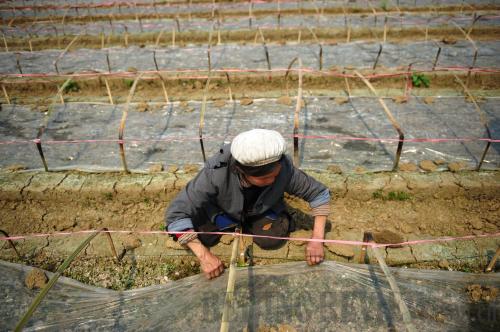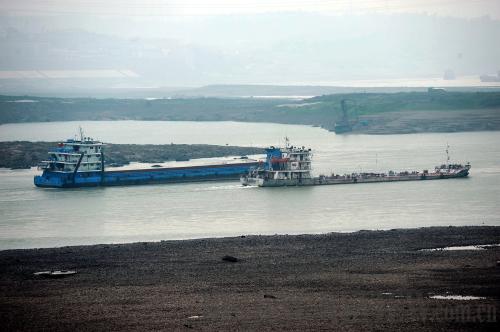|
 |
|
PROTECTING THE HARVEST: A farmer in Guizhou Province covers her crops with plastic film to prevent excessive sun exposure (LIU XU) |
Yunnan Province usually boasts one of the most abundant sources of water across China—ranking third among provinces nationwide. The origin of the Pearl River, which runs through the most vibrant economic center in south China, has recently seen its source of water cut off, leaving behind parched land and dead crops.
Economic losses have already started to mount in the face of the most severe drought to affect the southwestern region in decades.
Data from the drought- and flood-control department of Yunnan Province showed water storage at all local reservoirs was 5 billion cubic meters. It is estimated 90 percent of the water will be used up from February to May. If the rainy season fails to come by mid-May, a major proportion of Yunnan residents will be completely deprived of drinkable water.
China Meteorological Administration Deputy Director General Jiao Meiyan said a light rain would fall across a small area of land in the whole southwestern region toward the end of March. Jiao said the government would consider making artificial rain during the raining period to provide additional precipitation.
The lack of water in major rivers has also led to a drastic shortage of hydropower generation, which comprises nearly half of the region's electricity supply. Some rural areas are reportedly rationing power, while thermal power plants are overloaded.
Since September last year, weather disasters have continuously threatened crop growth and the living conditions of tens of millions of people. The northern and northeastern provinces, touted as the "bread basket" of the country, suffered a severe drought last fall that led to 50-percent agricultural losses, said a report of the McKinsey&Company of Greater China. From the beginning of this year until early March, frequent blizzards and low temperatures in north China again added to the misery of the region as a large number of crops were damaged by the drop in temperatures.
"Drought has caused more damage to agricultural output in recent years than other weather disasters, like flooding and frost," said Zheng Dawei, an agricultural professor at the China Agricultural University. Zheng said agricultural output undergoes fluctuations every four to five years, and major natural calamities are often accompanied by a string of secondary disasters.
Although China reaped bumper harvests over the past six years, per-hectare crop output and per-capita food did not increase accordingly. Soybeans, oil-bearing crops and cotton are mostly imported. Zheng said the foundation of food safety and food security in China is not solid.
Zheng warned frequent natural disasters in the near future could shatter agricultural production due to peculiar sun, oceanic and geological activities.
Frequent droughts
Zheng said, China suffers from more significant agricultural disasters than other countries worldwide, due to its location between two disaster belts—the pan-Pacific and Eurasia middle latitude—where earthquakes and geological disasters are frequent. A majority of China's territory is also situated in the continental monsoon climate region where the weather changes drastically from season to season, making agricultural production extremely vulnerable.
In the more than 700 years since the Yuan Dynasty (1206-1368), Yunnan has experienced over 200 droughts varying in intensity.
Xu Jianchu, a climate expert at the Chinese Academy of Sciences, supported the view that the El Nino phenomenon—a result of global warming—exacerbates the damages to atmospheric structure, preventing the ocean monsoon and moisture from entering inland areas. Increasing carbon dioxide emissions, the culprit of global warming, reduce temperature differences in the inland area and ocean, weakening the intensity of wind blowing from the ocean to the land.
 |
|
SHIPPING PROBLEMS: A ship navigates a section of the Yangtze River near Chongqing. The decreasing water level in this section of the river poses a major threat to ships in the region (ZHOU HENGYI) |
Yang Guiming, chief forecaster at the National Meteorological Center, attributed all extreme weather to global warming.
Statistics from the meteorological departments showed the average temperature in Yunnan this winter reached record highs since 1950.
"The polar glacier defreeze, caused by warming weather, leads to a rise in sea level, which will then swallow up large pieces of land," Yang said.
Global warming will also change the planet's climate zones. For instance, forests will move closer to the polar regions; middle latitude weather will become dry as deserts and grasslands expand; and contagious diseases will spread at a faster speed, Yang said.
The pursuit of economic benefits has also taken a toll. Some southwestern provinces have made a habit of cutting down primitive forests to grow water-consuming rubber trees and mallee, leading to rapid decreases in underground water levels and poor water-soil conservation.
But as huge tracts of fields dry out, authorities have come to fear another hazard: sinking land. Yunnan local media outlets reported the ground base of Kunming Wujiaba International Airport sank and cracked due to a lack of precipitation.
An inadequate irrigation network also plagues the region. Local farmers rely heavily on rainfall to irrigate their crops and are often reluctant to tap into the huge pool of water sources scattered throughout the province. Experts agree governments at all levels are duty-bound to provide sufficient irrigation system for farmers.
Long-term solution
The prevalence of extreme weather conditions underlines the importance of relieving agricultural disasters and tackling climate change. The McKinsey report estimated China would need to spend up to 25 billion yuan ($3.66 billion) each year between 2010 and 2030 to counter the effects of drought and avert substantial agricultural losses.
The Chinese Government has all but maxed out its efforts to secure a daily supply of water to drought-ridden areas, but climate experts reminded officials the expedient action would not serve as an ultimate solution to the natural disaster. Instead, more substantial efforts must be directed by the government, companies and individuals in combating global climate change.
To combat current and future agricultural disasters, Yan Denghua, an expert at the China Institute of Water Resources and Hydropower Research, suggested shutting down factories with water consuming inefficiencies. In the meantime, local companies should make full use of reclaimed or recycled water, while natural water should be reserved for human, plant and animal needs.
Zheng suggested setting up agricultural disaster relief administration at all levels of government since existing departments are not proficient in managing agriculture-related disasters. The new administration would work closely with meteorological, irrigation, geological and civil affairs departments to form a coordinated system, and strengthen monitoring and early warning methods.
The government and agricultural companies should promote practical disaster relief technologies among farmers and invent special facilities and equipment to fight agricultural disasters, Zheng said.
Farmers should grow crops and plants according to soil and weather conditions. To some extent, part of the crop failure was due to blind planting as farmers chose more profitable plants regardless of natural conditions.
Against the backdrop of global warming, the government as well as companies should foster drought-enduring and heat-resisting seeds, a development Zheng expects would be a trend in areas frequently affected by droughts.
To prepare for major disasters, agricultural departments should set up a storage system for seeds, herbage, fertilizer, pesticide, kerosene and pumps. Zheng also suggested storing crop seeds that can grow healthily on dry land.
Zheng highlighted the need to provide agricultural insurance to protect farmers from the inevitable loss of crops and livestock from droughts or other natural disasters. Trial insurance would be offered in major commercial crop production bases and then expanded to the rest of the country.
Xu said in a report assessing climate change in Yunnan that it is less likely for the province to have another major drought similar in scale to the current disaster in the near future. The drought, Xu said, is a periodical incident occurring every 30-50 years. But the province and the southwestern region at large cannot be negligent of the fact the extreme weather probability has not been reduced.
Xu, warning Yunnan might suffer serious flooding in the years to come, worried the current anti-flood facilities and procedures—like those meant to address droughts—are far from enough. | 